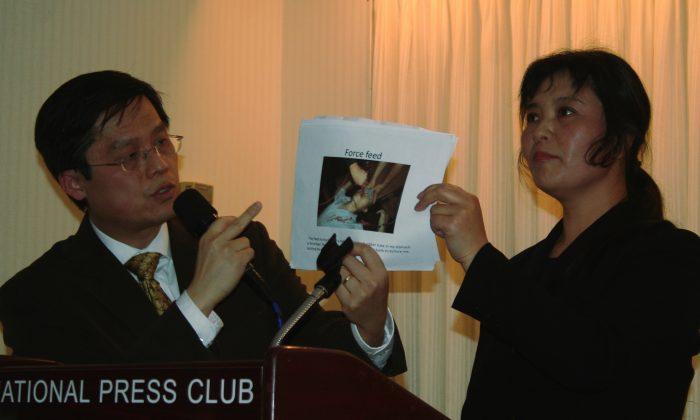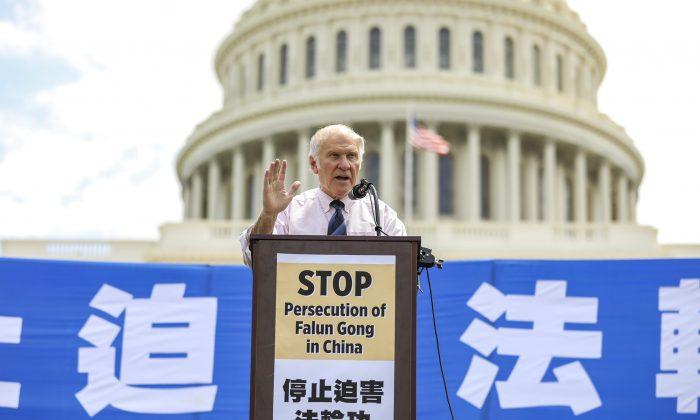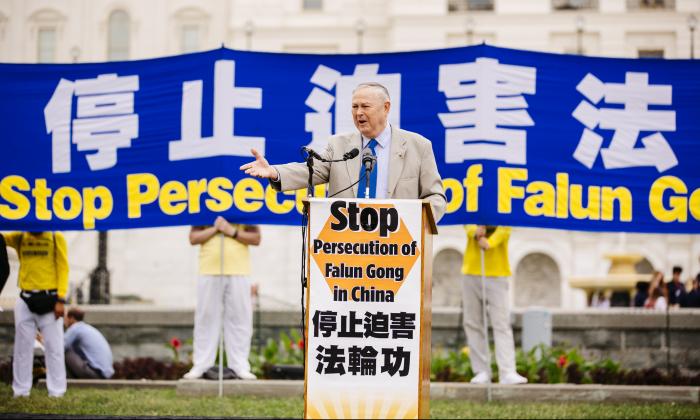WASHINGTON—After a mainland Chinese magazine published a detailed, 14-page exposé about torture in the Masanjia Labor Camp in northeastern China’s Liaoning Province, local Communist Party officials sought to discredit the magazine’s report. On April 24 in Washington, D.C., Falun Gong practitioners who suffered from the kinds of torture described in the magazine spoke about their experiences, rebutting the officials’ propaganda claims and filling in a major gap in the magazine’s report.
The April 6 article in Lens magazine, which ordinarily focuses on photography, was unprecedented—mainland China’s media have not been allowed to discuss the torture routinely used by the regime’s security forces. Interviews with former inmates and former and current officials at Masanjia Labor Camp described torture techniques in shocking detail.
Hundreds of thousands of Internet posts, many of them written in outrage, responded immediately to the article. Soon after its publication, the Central Propaganda Department of the CCP blocked the article and searches for the term, “Masanjia,” became unproductive.
The article touched a nerve among some regime officials and on April 19 the Liaoning Party Committee and government released the results of an investigative report that claimed the Lens article was a hoax, and no mistreatment had occurred at the camp.
The investigation bore the stamp of a propaganda effort. It was headed by the Liaoning official directly responsible for Masanjia and the team’s deputy head had served as director of Masanjia for several years, according to the Falun Dafa Information Center, the press office for Falun Gong.
The investigative team attributed the Lens magazine contents to “overseas Falun Gong media,” who they said “hate” the fact that so many Falun Gong practitioners have been “successfully transformed” there.
The team’s accusation about a connection to “Falun Gong media” was obviously false. Lens magazine, like all media in China, operates at the behest of the state. It is part of the Caijing media company, best known for publishing Caijing, an influential business newspaper.
Caijing is rumored to be closely associated with current Chinese Communist Party (CCP) head Xi Jinping, and analysts have speculated what signal he was sending by having the article published.
In July 1999 the then-head of the CCP Jiang Zemin launched a campaign to eradicate the spiritual discipline of Falun Gong, and the tortures practiced in Masanjia and other camps have played a major role in that campaign. The Lens article at the very least exposed a part of Jiang’s legacy that he has tried to keep under wraps.
Although false in trying to connect Lens to Falun Gong, the Liaoning investigative team’s statement is nonetheless very revealing. It showed that Masanjia had imprisoned a large number of Falun Gong practitioners, and that the camp has worked to “transform” these practitioners. “Transformation” involves forcing someone to renounce his or her beliefs and pledge allegiance to the Communist Party.
The World Organization to Investigate the Persecution of Falun Gong (WOIPFG) says, “The persecution of Falun Gong is a persecution against people’s belief. Therefore, brainwashing and transformation are at the core of the persecution. In order to force Falun Gong practitioners to give up their belief, so as to reach the ‘transformation rate,’ all sorts of torture methods have been designed, implemented and promoted.”
The Lens article did not discuss the purpose of the torture it detailed, nor did it discuss who that torture was being used on, although it did make reference to a “special group.” Within China, most readers accustomed to decoding the state-run media would have instantly recognized that the “special group” were the practitioners of Falun Gong.
While Lens magazine dared to discuss torture in detail, apparently the persecution of Falun Gong was too sensitive a topic for the magazine to take up.
At the National Press Club on April 24, four Chinese female Falun Gong practitioners presented the perspective absent from the Lens article—that of Falun Gong practitioners who resisted efforts by China’s labor camps to transform them. These practitioners, who were given asylum in the United States, had spent time in China’s forced labor camps, and one had spent over five years in total at Masanjia.
‘Transforming’ Practitioners
Falun Gong practitioner Wang Chunying described a particularly excruciating form of torture that she endured at the Masanjia Forced Labor Camp.
Wang had worked as a nurse and had developed many diseases, including hypothyroidism, an incurable chronic disease. After she took up Falun Gong, she ceased having physical problems and was grateful for it.
As someone who had benefitted from Falun Gong, she said she was determined to continue practicing after it was banned in China on July 20, 1999. She also felt she had to do all she could to stop the brutal persecution. Wang was arrested on five different occasions and was detained for a total duration of five years and seven months.
Wang described how on a cold winter day, she was taken to a special cell where there were two metal bunk beds, one on either side of the room. Six guards came into the cell and handcuffed one of the hands to the top bunk of one bed and the other to the lower bunk of second bed.
She was stretched out in this awkward position. Then the guards added to her agony by using their feet to push the beds further apart. Her hands and wrists soon turned purple. She was kept in this painful position for 16 hours, while they continued to “frequently kick the beds and shake my hands,” she said.
The reason for her torture was because she would not sign a statement that admitted guilt to a crime. She felt practicing Falun Gong was not a crime, and so she refused.
Another time, Wang was handcuffed this way for 23 hours. “I lost the feeling in both hands, which were dark and purple, and they were covered with blisters and broken flesh….In the next few months I couldn’t even hold a rice bowl. My hands were visibly deformed and had muscle atrophy,” she said.
Beatings
At the press conference, Ma Chunmei described the beatings she suffered in the interrogation room.
Ma, 44, originally from Liaoyuan City, Jilin Province in Northeast China, was separated from her 7-year old son, when she was arrested on Nov. 16, 1999 in Tiananmen Square and taken to Heihuizi Women Forced Labor Camp in Changchun for appealing to the central state to cease the persecution of Falun Gong.
She said that in May or June 2000, the CCP’s 610 Office ordered all Falun Gong practitioners to be brainwashed with the goal to “transform” all practitioners. The 610 Office is an extra-constitutional Party organ established by Jiang Zemin to persecute Falun Gong. So, one by one, practitioners were sent to an interrogation room to be tortured.
She said: “Once I was brought to an interrogation room and the guards used two electric batons to shock me simultaneously around my neck and my face. My skin instantly had red bumps, and the hair on the back of my neck burnt. They stomped on me, pulled my hair, punched me with their fists and also kicked me…Finally, I passed out, but they continued to beat me.”
Deprived of Sleep, Water
Falun Gong practitioner Wang Quiying had been in poor health with puerperal disease and other health problems that went away after she took up Falun Gong. Like Wang Chunying, she felt that as someone who had benefitted profoundly from Falun Gong, she said she had to do her best to stop the persecution. She went to Tiananmen Square and was arrested and sent to Tuanhe Dispatch Center in Beijing.
Wang Quiying remembers being sent to a room where she was forced to stand for 17 hours from 5 am to 10 pm with her head down. “This lasted nine days. My legs and feet were all swollen so much that I could not put my shoes on,” she said.
She was deprived of sleep and was only permitted to sleep a few hours a day.
She said the guards would torture her for no reason. During the hot Beijing summers they would torment prisoners by depriving them of water.
“We were only allowed to drink water twice a day in the hot summer and the water was rationed.” The cells were very hot and inmates fainted from dehydration. When it got really bad, her only thought was “water,” she said.
Caged Torture
Yu Zhenjie, 62, an accountant from Mudanjiang City, in far northeastern China’s Heilongjiang Province, suffered from many diseases, including postpartum apoplexy. Her health remarkably improved a month after she started practicing Falun Gong.
In 2000 she was sent to the Heilongjiang drug rehabilitation camp, where she said she was locked in an iron cage. Her hands and ankles were handcuffed and tied tightly to an iron chair, as a light was pointed at her face day and night. They injected her with drugs that made her limbs very weak and made her tongue feel rigid, she said.
Falun Gong spokesperson Zhang Erping feels the Lens magazine article has pointed out to media in the West a story that must be followed up.
“The Chinese journalists who wrote [the Lens article], those who printed it, and the interviews themselves have all taken an enormous risk to expose terrible crimes,” Zhang told the Falun Dafa Information Center. “It is imperative that we in the West don’t let their efforts be expended, their risks taken, in vain.”





Friends Read Free